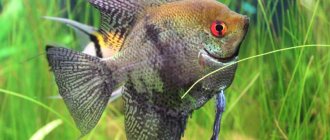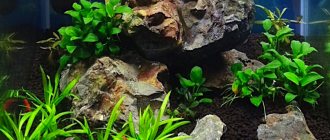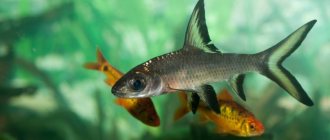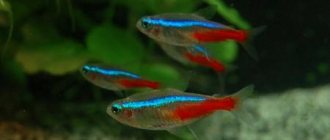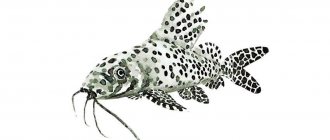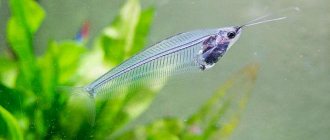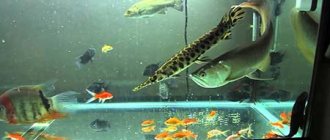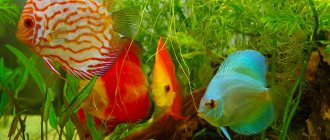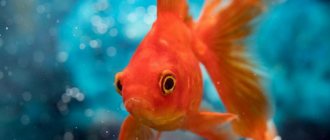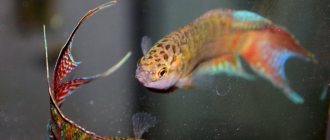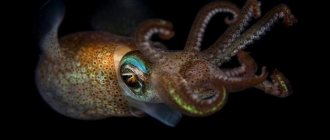In recent years, aquarium keeping has become increasingly popular. And this is not at all surprising, given that few people manage to resist the unique beauty of a beautifully designed artificial pond, which will not only become a wonderful decoration in any room, but also an excellent relaxation after a hard day at work. But no matter how hard any aquarist tries to create a bright and unforgettable design in his vessel, adding new decorative elements to it, its main decoration was and remains precisely the aquarium fish, of which the neon fish is a prominent representative.
Appearance
All neons are small gregarious species. The size of the fish rarely exceeds 4-5 cm. Neon males are smaller than females. The body is elongated and slightly flattened on the sides. The mouth is small. Neon fins are transparent, the anal fin is longer than the dorsal. Like other characin fish, neons have an additional adipose fin. This is an unpaired organ located behind the dorsal fin. It has no bone rays and consists of adipose tissue. Each fish has a longitudinal neon stripe on its body, which reflects light and creates a glowing effect. It is formed by special cells - chromatophores - located under the scales.
The neon stripe in neon females has a small kink in the middle, while in males it is a straight line.
Appearance of blue neon (Paracheirodon innesi)
Plants
In neon aquariums, areas with live plants are essential. You can create such areas along the walls of the aquarium, leaving a place for swimming in the center. Long-stemmed plants (vallisneria, elodea, cabomba, hornwort, etc.) are well suited. Eleocharis, a typical representative of South American aquatic flora, can be planted on the bottom. The spreading leaves of large echinodorus and cryptocorynes will create natural shade. For a similar purpose, you can also use floating pistia or riccia.
History of appearance/discovery
The history of the discovery and appearance of neon in hobby aquariums is closely connected with the French explorer and adventurer Auguste Rabot. It was he who first discovered small luminous fish in the Putumayo River (Peru). He was simply mesmerized by the beauty of these creatures and decided that he could earn a lot of money by exporting such a miracle. In 1935, the first copies of neon were sent to the United States of America and Europe. Aquarists of that time really liked the fish, the demand for it skyrocketed, and now Rabo is already becoming the world's only supplier of neon to the Old and New Worlds. For a long time it was not possible to breed neons in captivity, so the monopoly lasted for a relatively long time. One of the first copies was donated for advertising purposes to William Innesi, an amateur and popularizer of aquarium keeping. He, in turn, gave the fish to his friend George Myers, who made the first scientific description of a new species - blue, or ordinary neon, which he named in honor of his friend Hyphessobrycon innesi. The species later changed its name to Paracheirodon innesi.
Red neon (Paracheirodon axelrodi) was discovered only in the middle of the 20th century. The descriptions were made in parallel by two scientists - Myers and Schultz. But the latter published his work earlier, so the name he gave to the fish in honor of his friend the aquarist Herbert Axelrod was fixed in the nomenclature.
In 1963, Jacques Gehry discovered another type of neon - emerald neon, or simulant neon. The sample he caught was very similar to the red neon, but his further study led to the identification of these fish as a separate species. Gehry also carried out a systematic revision of neons and assigned them to the genus Paracheirodon, which is how they are called to this day.
For the first time, it was possible to obtain offspring from neons in captivity in Germany. This happened by a happy coincidence, and was due to the fact that this country has very soft water, which was used to contain neons. At the beginning, the spawning of neons was called a “German miracle,” but the first studies revealed the mechanisms of the influence of water parameters on the reproduction of these fish. From now on, neons become available to all aquarists in the world.
Nowadays, fish are grown en masse on special farms in Southeast Asia. Although occasionally there are also deliveries of wild neons caught in the natural environment.
Location
Blue neon is a popular aquarium resident in all countries of the planet, but its habitat is narrow: it can be found in the wild only in small rivers and streams in Brazil, South. America, Peru and Colombia, which are characterized by not intense currents or its complete absence. The water in such places has an acidic environment due to constantly rotting leaves and roots, which also give it a brownish color and do not allow excessive sunlight to penetrate.
Perhaps it is precisely because of the low level of illumination that neon is endowed with such a bright appearance, because this way it is much easier not to get lost from the flock.
Habitat in nature
Neon vulgare was first described by Gehry in 1927. They live in South America, their homeland in the region of the Paraguay, Rio Tacuari, and Brasil river basins.
In nature, blue neons prefer to inhabit slow tributaries of large rivers. These are rivers of dark water that flow through dense jungle, so that very little sunlight reaches the water. They live in flocks, live in the middle layers of water and feed on various insects.
At the moment, neons are very widely bred for commercial purposes and are practically not caught in the wild.
Motherland
Neon fish originated from South America. This is where their homeland is, where they live in clean reservoirs with soft water. They are also found in the rivers of southeastern Colombia and eastern Peru. They love shade, so they choose places with dense vegetation, where the sun's rays practically do not reach. They live in groups of 10 or more, so they should never be kept alone in an aquarium as they rely on each other.
The reservoirs of the Amazon River basin are native to neon birds.
The first neon fish imported into France in 1934 sold for $6,500.
Description
This is a small and slender fish. Aquarium fish blue neons grow up to 4 cm in length and they live for about 3-4 years. As a rule, you don’t notice their death, it’s just that the flock gets smaller and smaller year after year.
Neon is distinguished primarily by a bright blue stripe running across the entire body, which makes it very noticeable. And in contrast to it, there is a bright red stripe, which starts from the middle of the body and goes to the tail, slightly extending onto it. What can I say? Easier to see.
FEEDING NEONS
Properly selected food plays an important role. Its main characteristics are nutritional value, content of essential vitamins, and mineral content. Also, its shape should be convenient for neon to eat. To feed the fish, dry and freeze-dried food is used, which should be alternated with live or frozen food (bloodworms, brine shrimp, small daphnia, coretra, etc.). One day a week should be a fasting day. Otherwise, constant feeding of protein foods leads to obesity in the fish. Food should be given once or twice a day so that the neons eat it within a few minutes.
What are the dangers of overfeeding and lack of a fasting day? Due to obesity, cysts form and the fish become infertile. General health worsens, immunity drops, and eventually neon dies.
Content
With proper care, selection and maintenance of temperature conditions, you will never have problems with the maintenance and reproduction of neons.
Neon maintenance conditions:
- Water temperature 18 – 24 °C. If you plan to breed fish, the water temperature should be from 22 to 24 °C. Neons can also be kept at water temperatures up to 28°C, but the life expectancy is reduced by more than half. That is, the neon will live no more than two years.
- Water hardness up to 8°
- Acidity pH 5-6.5
- It is advisable to use only water .
- to change water weekly, up to 30% of the total water volume.
- Aquarium. The aquarium may be small, but keep in mind that this is a schooling fish and you need to take several neons. Count on a little more than one liter of water for one neon, that is, for a 50-liter aquarium you can take up to 40k of neons.
- Plants are also needed. Neon fish loves vegetation very much. Vegetation is needed for the neons to hide. In a densely planted aquarium, neons will be much more comfortable.
- Priming. The soil doesn't really matter. You can take small pebbles. It is advisable to use a primer as dark as possible, preferably black. This is because neon colors are practically invisible on a light ground, but on a black background the colors of the neon fish are expressed much better.
- Lighting should be moderate; it is advisable to arrange a dark place with plants.
Aquarium decoration
In order for the neon to feel comfortable, it is necessary to properly design the aquarium, which will remind them of their natural habitat. Then they will get sick less and always be in a playful mood.
So, how to properly decorate an aquarium:
- A neon house should be spacious. You should purchase aquariums with at least 20 liters of water for a flock of 5 neons.
- You can reproduce the natural habitat for these fish using dark soil. It can be dark sand or pebbles. In addition, against such a background the fish will look even brighter and more beautiful.
- Vegetation should be voluminous and dense. This can be algae, elodea, hornwort, cabomba, vallisneria.
- You can place various driftwood and coconut shells at the bottom. Such shelters will serve as houses for fish, in which you can hide in times of danger.
- Adding a few dried leaves or alder cones to the tank will turn the water a light brown color, similar to the water in their river. It is important to remember to replace the leaves every week to prevent them from contaminating the water. Do not use resinous tree species under any circumstances!
- A lid on top of the aquarium is optional. Bright light is also not a good idea, as it can make them stressed and want to hide.
A neon aquarium is like a picture frame. These beauties don't need fancy design.
These fish are popular due to their rainbow glow. The thing is that in their body there are cells called “iridophores”. These cells contain guanine crystals, which can reflect light and make certain colors appear brighter when struck.
Owner reviews
I have been keeping an aquarium for several years now. And so I decided to add neon. I purchased a group of 8 fish. They look very nice. I noticed that if something changes in the conditions of detention, the blue stripe that always glows on them becomes very dim. And if the cause is not discovered in time, the fish may die. Vladimir 46 years old, Ufa
Just today I launched a new aquarium and added 28 blue neons to it. Just a peek. I just read the article and realized that it was impossible to do that. Now I don’t know whether my fish will survive, whether they will be able to settle down and adapt on their own. Elena Petrovna 58 years old, Krasnodar
I don’t know much about aquarium fish, but I recently bought an aquarium for my son, who constantly asks to take him to the pet store to look at the fish. So we decided to surprise him. We would like to stock neons, guppies and bottom-dwelling catfish. As far as I understand, they will get along with each other. Alexander 35 years old, Volgograd
Reproduction
Neons reach sexual maturity at eight months and retain the ability to spawn for up to 4-5 years, of course, provided they are kept in optimal conditions. Ideally, immediately before planting for spawning, the spawners should be seated for a week in different containers with a water temperature of 22℃ .
At this time, you need to feed intensively and variedly, be sure to include live food in the diet. To dilute neons, prepare a solid glass container with a volume of 10-20 liters. Disinfect it and fill it with distilled water. Add 200 ml of water from the aquarium containing neons. At the bottom of the spawning tank, place a bunch of Java moss (if you are 100% sure that there are no snails on it) or a nylon sponge.
The main thing in breeding neons is to properly prepare the water. Neons can lay eggs in any water (even in a general aquarium), but fertilization is possible only in soft water (up to 3°). It is optimal for the rigidity to be about 1°. Neons prefer to spawn in slightly acidic water (pH 5.5-6). You can acidify it with folk remedies - for example, a decoction of alder cones, a peat decoction, or you can use special preparations (fortunately, there are plenty of them on sale now).
Do not blow too much air in the spawning tank, raise the temperature to 25-26℃ and you can start the spawners. Shade the breeding aquarium on all sides, leaving only one corner dimly lit to see the results of spawning. Everything should be done by morning. The bulk of the eggs should be on the substrate and under it. It is necessary to place the breeders back into the general aquarium, and carefully shake off the eggs from the substrate to the bottom.
Reduce the water level in the spawning tank with eggs to 7-10 cm and add an antifungal drug (for example, methylene blue or General Tonic). At a temperature of 25℃, eggs develop in 36-48 hours. The fry first hang on the glass, then begin to swim. Feeding neon fry is very difficult. At an early age, neon fry see very poorly; they only develop an orientation towards light - phototaxis. This is what you need to use for feeding. The entire aquarium must be darkened, leaving only a ray of light in one corner.
In the illuminated place, ciliates necessary for feeding the fry will accumulate. With such lighting, the neon fry will not remain hungry; when they find themselves in a cloud of ciliates, they begin to actively feed. This makes it possible to save all the young. Gradually, the fry are transferred to feeding on Artemia nauplii and rotifers, and then on small cyclops. It is gradually necessary to increase the hardness of the water in the spawning tank with the fry, adding a small portion of water from the general aquarium daily.
Neon diet
Any inhabitants of the aquarium must be fed in a balanced and timely manner. Any fish is naturally omnivorous and voracious, and the only one who can control the amount is the owner. The diet should include both dry and live food. You can buy them at a pet store, from suppliers, or prepare them yourself.
Blue neon, like any other fish, is not averse to eating live food.
Neon fish usually grab food in the water density, and less often remove food from the surface of the water. The size of their mouths is very small, so you need to carefully monitor whether the babies are eating well. If the granules are too large, the fish may not cope and end up without a meal.
You can't give fish a buffet. One meal - one type of food (either dry or live), otherwise the harm to health will be irreparable . Neon gourmands can absorb food without stopping - nature has endowed fish with this property for a good purpose. But for aquarium inhabitants, gluttony is destructive. A neon fish can fill its belly to such an extent that death becomes inevitable. You need to give your baby as much food as he can eat in 2-3 minutes. The rest needs to be fished out, otherwise the food will sink to the bottom and begin to decompose, contaminating the water with ammonia.
It is advisable to pre-freeze and crush live food, and only then give it to the fish. Neons are very fond of bloodworms, daphnia, and tubifex. All this must be frozen, since live food is often infected, and the fish are poisoned to death.
Video: Feeding Blue Neons
If there are other fish adjacent to the neons, you need to observe whether all the pets have time to enjoy the food. Neons are more “compliant” than other species and, when fighting for food, as a rule, remain a voluntary loser. Several such defeats - and the fish faces starvation.
Compatibility with other inhabitants
If you plan to keep different types of fish in the aquarium, then it is important to select peace-loving inhabitants who will not harm the neonates. You need to choose neighbors based on similar temperament. With large inhabitants, aquarium “fireflies” can lose their color and are constantly in a state of stress.
The compatibility table for neons clearly shows who should be preferred as neighbors.
The following will get along with friendly neons:
- guppy;
- mollies;
- swordtails;
- labeo;
- ancitruses;
- corridors;
- zebrafish;
- tetras;
- shrimps;
- snails;
- iris.
Neons will not be able to get along with fish that have aggressive characters. These are barbs, large catfish, astronotus, bettas, and koi.
Diseases
The most common neon disease is plastiphorosis. It is infectious in nature, the causative agent is a pathogenic fungus that parasitizes the muscular system of fish. It can be brought into the aquarium by other infected fish or untreated water.
The symptom of this disease is fading of color and body position with the tail up.
There is no treatment for plastiphorosis. They destroy not only sick individuals, but also everyone in the aquarium, since even a seemingly healthy fish can be a carrier of a harmful fungus. The aquarium is cleaned and disinfected.
Health
Neons have the ability to lose their brightness during the night. This makes them less accessible to predators. But if the color disappears during the daytime, this may mean that the fish is sick.
The reasons that can affect the health of individuals can be different:
- insufficient oxygen;
- improper feeding (usually overfeeding);
- water temperature (below 15-16 C°);
- water pollution;
- pathogens.
Neons are most often susceptible to the following diseases:
Plistiphorosis
This is the most common disease that kills neon fish. Its second name is “neon disease”. The fungus affects the muscles. The first symptom is a pale color and neon stripe. As the disease progresses, the fish becomes completely discolored and swims on its side or upside down. Then he dies. The disease is contagious, so the sick individual must be quarantined or killed. There is no treatment.
Saprolegniosis
The causative agent is also a fungus. The main causes of infection are poor aquarium hygiene, unbalanced nutrition and overcrowding. You can notice that the fish is sick by a spore-like coating and gluing of the fins.
